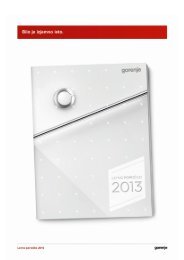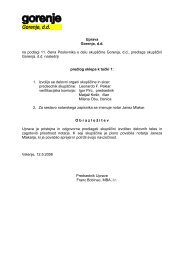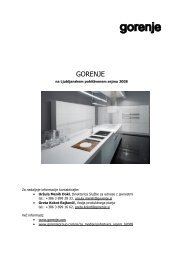ANNUAL REPORT 2008 - Gorenje Group
ANNUAL REPORT 2008 - Gorenje Group
ANNUAL REPORT 2008 - Gorenje Group
Create successful ePaper yourself
Turn your PDF publications into a flip-book with our unique Google optimized e-Paper software.
129<br />
In the first two months of 2009, the <strong>Group</strong> faced a 20 to 25-percent drop in the operations, the<br />
downward trend remaining similar to the one in the last few months of <strong>2008</strong>. The majority of the<br />
manufacturers operating in the business segment recorded a loss in the last Quarterly of <strong>2008</strong>.<br />
Therefore numerous activities were launched in December <strong>2008</strong> whose purpose is to neutralize the<br />
negative impact of the extremely low sales. They are directed to all areas of the <strong>Group</strong>’s operations<br />
and all business processes, relating to:<br />
• the cost management of raw materials (inventory optimisation, favourable term<br />
purchase of raw materials, further development of supply sources from Asia in<br />
other dollar-based supply markets and South-Eastern European countries, further<br />
cost-cutting measures to be adopted in association with the cost of materials),<br />
• production process (flexibility in the adaptation of the production to the level<br />
of orders),<br />
• purchase of goods (adjustment of purchases to the current requirements),<br />
• sales (sales promotion, intensifying of customer contacts, search for new business<br />
opportunities, simplification),<br />
• costs of logistics (maximizing the utilization of transportation means),<br />
• investments (approval of solely the most urgent investments whose purpose is<br />
new product development),<br />
• marketing area (cost-cutting in all markets, limiting the costs to costs that are directly<br />
linked to sales promotion),<br />
• costs of services (decrease in the management and general administration<br />
costs, adaptation of costs to the range of sales, strengthening the control over<br />
the cost base),<br />
• assurance of positive cash flows (raising new long-term loans, receivables optimisation,<br />
assuring short-term liquidity),<br />
• a decrease in current assets (management of inventories and receivables) and<br />
• labour cost optimisation (implementation of a 36-hour weekly working time, a<br />
10-percent salary decrease, organisational restructuring and restructuring of<br />
business processes).

















